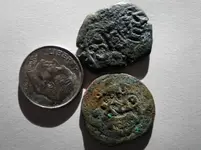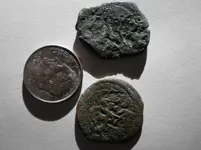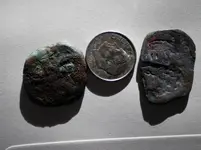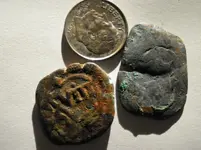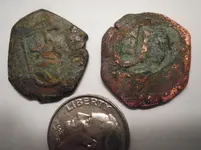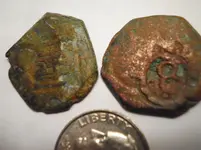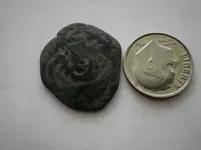It's possible someone scattered them their on purpose. Fee-bay is loaded with lots like these. Just my two bits.
hi tarpon anything could be possible.but it would seem like a lot of trouble to pull a prank.plus with the way they look with the sand stuck to them and the blue from the copper leaching out i would guess they have been in the groung a while.
To touch on what "tarpon..." mentioned... to a sane person, yes, seems like it would be a lot of effort to screw with someone in this manner, but these can be had cheaply (see below), so it wouldn't be expensive at all. Seems like a lot of effort to go out your way to, say, torture an animal... AND THEN you read about the "person" that sticks a kitten in an oven... More on topic, how many times have you read on here where someone detected that same old ca.1620 Mexican 8R cheapo Atocha-style cast... even at a fairly well-buried depth b/c of shifting sands/soil??
Also related to the point of how plentiful they are out of Spain on eBay... because of that, I'm always suspicious when I see reports of maravedis finds here in the Americas (particular ex-Spanish territory now in the U.S. - Florida, California...). As has been stated, this was the copper small change of (home country aka "peninsular") Spain... generally 34 mrvd = 1 real, though the rate fluctuated, there were revaluations of older pieces as seen on a few of diminator's finds, etc.). Like tarpon said, you can buy handfuls of metal detected pieces out of Spain, likely all found in clusters... usually with a telltale sandy patina to them... and they be had cheaply like Roman pieces (under $1 a piece, depending on condition/quantity). Thus, they are ripe targets for eBay flippers who will sell them individually for maybe $5-10, calling them Spanish pirate treasure cobs to get the target audience's knickers in a bunch.
An extension of this is that certain resellers will extend the BS into an outright lie, claiming that these were found on American soil - thus transforming them into magical, historical COLONIAL AMERICA... Spanish pirate treasure cobs. I have observed several instances where the I've seen that a seller bought some of these lots from Spain sellers and some weeks later, listed them in such a manner. There's one seller along these lines who actually claims they themselves dug them on a trip to Spain!!
Now, that said... I honestly don't know much about the circulation of the maravedis copper coinage in the Spanish colonies (incl. Florida and California/what we won in the Mex. War). Obviously some would have at least made it over from Spain in pockets/personal stashes, and very early on (early to mid 1500s) some were actually produced at Santo Domingo (DR), but I don't believe they were imported/used here in any great quantity. What they used predominantly for small change, I don't know... I focus on the silver... HOWEVER, I have seen enough on boards like this one and a Mexican treasure hunting site I peek at once in a while about finds supposedly made on this side of the Atlantic to be convinced that at least SOME made it here (mainly earlier cob maravedis of the late 1500s-early/mid 1600s, like these pieces... really never the later milled portrait types). Clearly, dimeinator's finds are examples of this.
Could be a pocket spill (was the coastline further out at that spot back then??)... maybe a small wreck that wasn't necessarily transporting any great quantity of bullion coinage... who knows. Interesting finds, though.
BTW - the roundish ones, minted in Segovia (with the aqueduct mintmark) aren't actually "cobs" by style but milled coinage... Segovia in the late 1500s well into the 1600s was the one Spain mint that had this minting technology (though they were still producing some hammered silver cobs).





